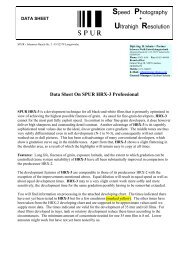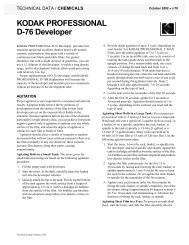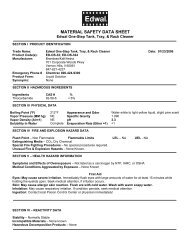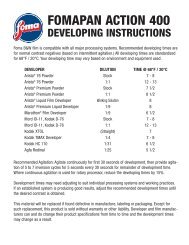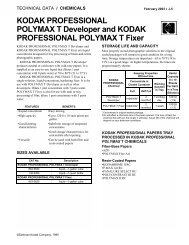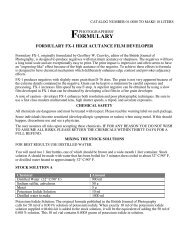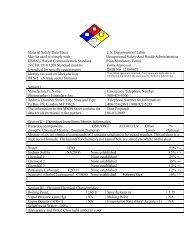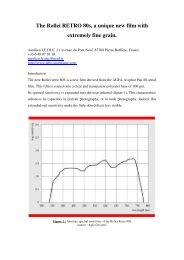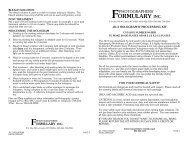Instructions & Technical Data (pdf)
Instructions & Technical Data (pdf)
Instructions & Technical Data (pdf)
You also want an ePaper? Increase the reach of your titles
YUMPU automatically turns print PDFs into web optimized ePapers that Google loves.
CATALOG NUMBER 06-0120 TO MAKE 1 LITER<br />
CATALOG NUMBER 06-0130 TO MAKE 2 LITERS<br />
CATALOG NUMBER 06-0140 TO MAKE 4 LITERS<br />
PHOTOGRAPHERS'<br />
FORMULARY<br />
FORMULARY NELSON GOLD TONER<br />
Nelson Gold Toner produces tones that vary from just a hint of warmth to rich sepia-browns. The<br />
depth of the tone depends upon the duration of time the print remains in the toning bath and the type<br />
of paper used. The toner is useful in portrait photography where it can be used to diminish the impact<br />
of cold black tones.<br />
FOR YOUR CHEMICAL SAFETY<br />
All chemicals are dangerous and must be treated with respect. Please read the warning label on each<br />
package of chemicals. Three chemicals in this kit need special attention.<br />
SILVER NITRATE: Is a caustic and may cause skin burns. If you wish to dispose of solid silver<br />
nitrate, wash it down the drain with excessive amounts of water.<br />
If solid silver nitrate should come into contact with the skin, a chemical burn may result. Wash the area<br />
with cold water followed by soap and water. Treat any chemical burn the same manner you would treat<br />
a heat burn. When spilled on the skin, dilute solution of silver nitrate will cause the skin to turn brown.<br />
The brown color is due to silver metal bound to the protein of the skin and cannot be washed off.<br />
While there are chemical methods for removing the brown stains, the best procedure is to just let them<br />
wear off.<br />
GOLD CHLORIDE: like silver nitrate, is a caustic and can cause skin burns. In dilute solution, gold<br />
chloride will stain the skin purple. The purple stain cannot be chemically removed. The only procedure<br />
for removal of the spots is to let them wear off. If you are concerned with finger stains, we strongly<br />
urge you to use rubber gloves, such as Playtex gloves, when working with this toner.<br />
The user assumes all risks upon accepting these chemicals. IF FOR ANY REASON YOU DO NOT<br />
WISH TO ASSUME ALL RISKS, PLEASE RETURN THE CHEMICALS WITHIN 30 DAYS<br />
FOR A FULL REFUND.<br />
Consult with local sewer and water authorities regarding proper disposal of darkroom chemicals in<br />
your area.<br />
MIXING THE SOLUTIONS<br />
Stock Solution A<br />
To prepare Stock Solution A, two solutions (called Solution 1 and Solution 2) will be prepared first<br />
then mixed. You will need two temporary containers. One container should have a capacity of 1 liter<br />
(or 2 or 4 liters) and the other temporary container should have a capacity of 16 ml (or 32 or 64 ml).<br />
You will also need a storage container.<br />
NELSON GOLD TONER PHOTOGRAPHERS PAGE 1<br />
CAT NOS. 06-0120, -0130, -0140 FORMULARY 800-922-5255<br />
Solution 1
Chemical 1 liter 2 liter 4 liters<br />
Distilled water (52°C/125°F) 750 ml 1500 ml 3000 ml<br />
Sodium Thiosulfate, anhydrous 152 g 305 g 611 g<br />
Potassium persulfate 30 g 60 g 120 g<br />
Distilled water to make 1000 ml 2000 ml 4000 ml<br />
Sodium thiosulfate, pentahydrate can be substituted for the andhydrous form.<br />
Use: 240 g 480 g 960 g<br />
Place the warm water in a temporary-mixing container, add the thiosulfate, and stir until it dissolves.<br />
Add the persulfate and stir vigorously. The solution should turn milky white. If it does not turn milky<br />
white, then the water was not warm enough. In such a case, warm the solution until its temperature is<br />
greater than 52°C/125°F. Precipitation of the milky white material is normal.<br />
Solution 2<br />
Chemical 1 liter 2 liter 4 liters<br />
Distilled water (20°C/68°F) 16 ml 32 ml 64 ml<br />
Silver nitrate 1.3 g 2.6 g 5.2 g<br />
Sodium chloride 1.3 g 2.6 g 5.2 g<br />
Solution 2 is mixed in a container that is different from that of Solution 1. The two solutions will be<br />
mixed in a subsequent step. Place the water in the container and add the silver nitrate. Stir until all of<br />
the solid dissolves. All of the silver nitrate must dissolve before the sodium chloride is added;<br />
otherwise, solid silver nitrate will be trapped in the solid that forms. Add the sodium chloride. A white<br />
precipitate will form. Stir vigorously.<br />
Combining solution s 1 and 2<br />
Both solutions must be at room temperature (20°C/68°F) before they are combined to make Stock<br />
Solution A. Stir Solution 2 vigorously to disperse the solid throughout the solution, then pour all of<br />
Solution 2 into Solution 1. Stir the combined solution to ensure thorough mixing.<br />
A precipitate may or may not be present in the final solution. Transfer the combined solution along<br />
with any precipitate (if present), to the storage container.<br />
Stock Solution B<br />
Stock Solution B is a gold chloride solution and should be prepared in its storage container.<br />
Chemical 1 liter 2 liter 4 liters<br />
Distilled water (20°C/68°F) 62.5 ml 125 ml 250 ml<br />
Gold chloride .25 g .50 g 1.0 g<br />
Gold chloride is deliquescent and rapidly absorbs atmospheric moisture. The solid may have liquefied<br />
by the time you receive it. Since you will be transferring it to a water solution, prior liquefaction is not<br />
detrimental. However, when gold chloride liquefies, some of the liquid clings to the cap of its<br />
container. Because of the small amount of gold chloride used in this kit, it is imperative that all of the<br />
residual gold chloride in the vial be transferred when you prepare Stock Solution B.<br />
Measure the correct amount of water needed in a graduated cylinder. Place a plastic funnel on the<br />
Solution B container. Using an eyedropper, add some water to the gold chloride vial then wash the<br />
contents of the vial into the container with additional water.<br />
NELSON GOLD TONER PHOTOGRAPHERS PAGE 2<br />
CAT NOS. 06-0120, -0130, -0140 FORMULARY 800-922-5255<br />
Wash the vial itself, the cap threads on the vial, and finally the cap. When gold chloride is present in<br />
the wash water it will be yellow. When you are convinced that all of the gold chloride has been
transferred, pour the water remaining in the graduated cylinder into the Solution B container. Cap and<br />
shake (or stir) the container to ensure the solution is homogenous.<br />
MIXING THE WORKING SOLUTION<br />
To prepare the working solution, one-half of Stock Solution B is added to Stock Solution A. The<br />
remaining one-half of Stock Solution B is used as a replenisher for the working solution.<br />
Volume of Stock Solution B to be added to Stock Solution A to prepare the working solution<br />
Kit Size<br />
Volume of B<br />
1 liter 31.5 ml<br />
2 liters 62 ml<br />
4 liters 125 ml<br />
Measure the correct volume of Stock Solution B in a graduated cylinder and pour it into Stock<br />
Solution A. (Be sure the container for Stock Solution A will hold the combined volumes.) Cap and<br />
shake (or sir) the resulting mixture to ensure it is homogenous. Set the working solution aside until a<br />
precipitate has formed and settled. An overnight standing should be sufficient. Do not use the working<br />
solution until the sediment has formed.<br />
USING THE TONER<br />
Before toning, a wet, freshly fixed printed should be washed a few minutes. Dry prints should be<br />
soaked in water. For best results, use two prints: one to be toned and one for comparison.<br />
Very carefully decant the working solution into the tray. Do not pour the sediment in the working<br />
solution into the toning tray.<br />
For proper toning, the working solution must be maintained at a temperature between 38°C/100°F and<br />
43°C/110°F. If you do not have a special warming tray, use the two-tray procedure for warming. Place<br />
hot water in a large tray and float the toning tray on the hat water. Add additional hot water to the large<br />
tray as necessary. DO NOT HEAT THE TONING SOLUTION IN A MICROWAVE OVEN - IT<br />
WILL RUIN THE TONER SOLUTION.<br />
Place the print to be toned in the solution and tone to the desired hue. When the desired tone has been<br />
reached (5 to 20 minutes), rinse the print in water; fix the print for 5 minutes; and finally wash the print<br />
for at least one hour.<br />
When the toning session is complete, return the working solution to its storage container.<br />
REPLENISHMENT<br />
Exact measurements cannot be given. The quantity to be added will depend on the number of prints<br />
toned, and the time of toning. In general, when toning to a warm brown, about 4 ml of solution B<br />
should be added to the working solution after each fifty 8-by-10 prints have been toned.<br />
PHOTOGRAPHERS'<br />
FORMULARY INC.<br />
PO Box 950 • Condon MT 59826 • 406-754-2891 • FAX 406-754-2896<br />
Web: www.photoformulary.com E-MAIL formulary @montana.com



